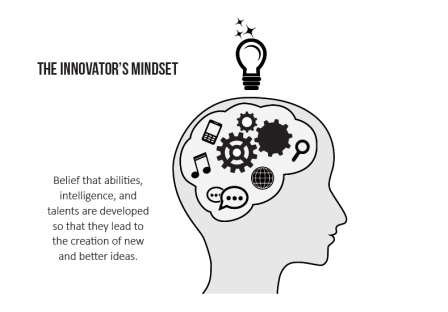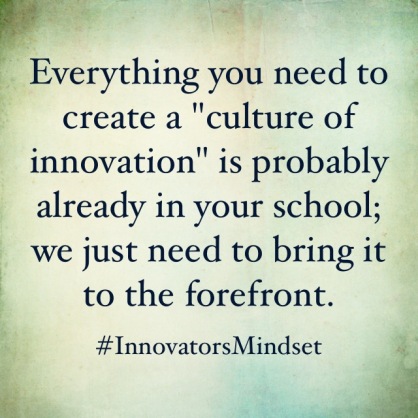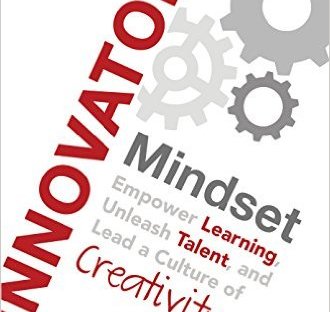Of all the professional reading I’ve delved into this summer, none have impacted my thinking as much as George Couros’ The Innovator’s Mindset. Couros’ work has an incredible number of takeaways, but I want to focus on my top three insights from the book. Before I delve into those, let’s examine Couros’ definiti on of an innovator’s mindset. Couros builds upon Carol Dweck’s growth mindset (the belief that abilities, intelligence, and talent can be developed) and asserts that the innovator’s mindset is “the belief that the abilities, intelligence, and talents are developed so that they lead to the creation of new and better ideas.” School leaders must endeavor to foster a school culture that serves as a springboard for innovative thinking and invigorates the minds of all stakeholders to create ideas, connect to the ideas of others, and improve on the ideas of others.
on of an innovator’s mindset. Couros builds upon Carol Dweck’s growth mindset (the belief that abilities, intelligence, and talent can be developed) and asserts that the innovator’s mindset is “the belief that the abilities, intelligence, and talents are developed so that they lead to the creation of new and better ideas.” School leaders must endeavor to foster a school culture that serves as a springboard for innovative thinking and invigorates the minds of all stakeholders to create ideas, connect to the ideas of others, and improve on the ideas of others.
The three most powerful ideas of The Innovator’s Mindset that resonate with me are:
- Connection- to students, other educators, to learning
- Empowered Learners
- Learner is Driver, Technology is Accelerator
We are presently living in a connection economy in which our connections to others and connections to ideas are interwoven throughout our daily lives. One of the most powerful assertions in Couros’ work is, “If we want meaningful change, we have to make a connection to the heart before we can make a connection to the mind.” Wow! We know that students are profoundly influenced by the positive interactions they have with us and we know how important it is that we take that knowledge to heart, but how often do we really remind ourselves of the monumental impact our relationship building is on all aspects of our work as educators?
School culture has an incredible influence on the ability of educators to engage students in innovative learning opportunities and encourage them to become innovators themselves. We must work to foster a spirit of collaboration among our leaders, teachers, and staff members so that our students have a model for their own collaborative work. The school community must be supportive and nurturing for all stakeholders to provide an optimal environment for innovative thinking to thrive and expand.
A key component of this community is the shared belief that individual growth leads to collective growth. Couros contends that, “effective leadership in education is not about moving everyone from one standardized point to the next but moving individuals from their point “A” to their point “B.” Leaders must meet teachers where they are and likewise, teachers must do the same for their students. When we make demands of our teachers that can be overwhelming for some, they may be more apt to cling to the “old way” of doing things or to that which is familiar. However, if we come alongside them and seek to personalize an approach that is manageable for where they are in their thinking, the results will be positive for all involved. The same is true for students. Incremental, personalized growth is empowering.
Another key takeaway for me is Couros’ discussion of empowered learners versus engaged learners. Educators often talk about the need to develop instruction that engages students in meaningful learning opportunities. Though engagement is a huge piece of the work we do, we should put our focus on developing instruction that empowers our students. Couros cites Bill Ferriter’s definitions of engagement and empowerment in his book. Ferriter indicates that, “Engaging students means getting kids excited about our content, interests, and curricula.” While empowering students “means giving kids the knowledge and skills to pursue their passions, interests and future.”
We must spend time getting to know our students’ strengths and tailoring instructional tasks that allow them to thrive while challenging them to higher standards. We must also ensure that we are connecting with students as individuals and empowering them to become passionate learners. Our students must be able to make meaning, construct, and create learning. To engage and empower our students to become innovators we must provide them with rigorous instructional tasks that require evaluation and creation. Couros identifies eight things to look for in today’s classrooms to promote a vision for innovation. Today’s classrooms should be learner focused, providing students with voice, choice, time for reflection, opportunities for innovation, critical thinking tasks, problem solving tasks, self-assessment, and opportunities to connect their learning with real world application.
My third powerful takeaway from The Innovator’s Mindset is the notion that “learners are the driver and technology is the accelerator.” Sometimes we can be tempted to incorporate technology simply for the sake of being tech-integrated. We need to intentionally embed technology in meaningful ways so that student learning is maximized. According to Couros, when considering a new technology resource or instructional practice that utilizes technology or in the development of instructional technology policies, we should ask ourselves the following questions. What is best for kids? How does this improve learning? If we were to do______, what is the balance of risk vs. reward? Is this serving the few or the majority?
Couros’ work is full of many other rich ideas that I plan to further explore and experiment with in the coming school year. His ideas resonate with me and challenge me to become a leader who embodies the innovator’s mindset and most importantly, empowers students to become passionate learners. You can learn more about George Couros and his work here: George Couros’ Blog


One thought on “Embracing the Innovator’s Mindset”